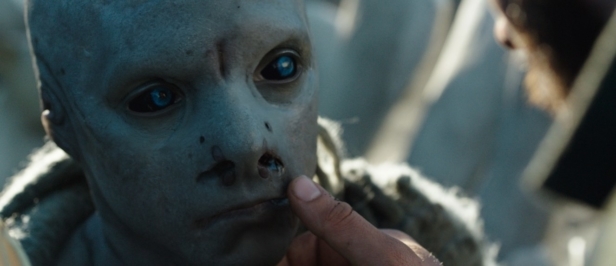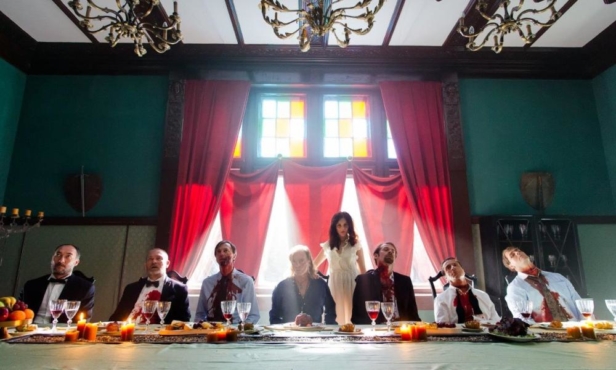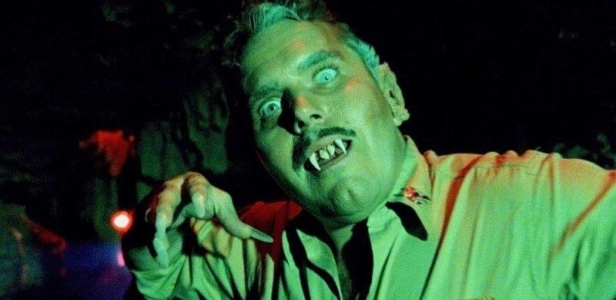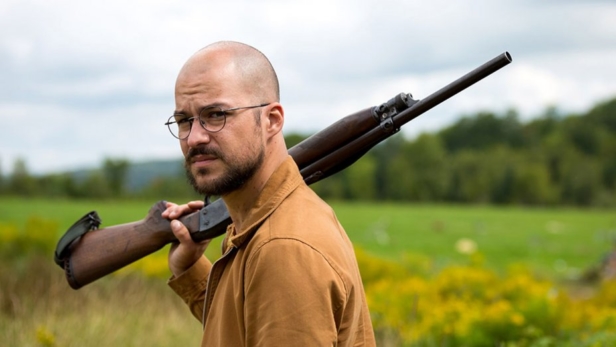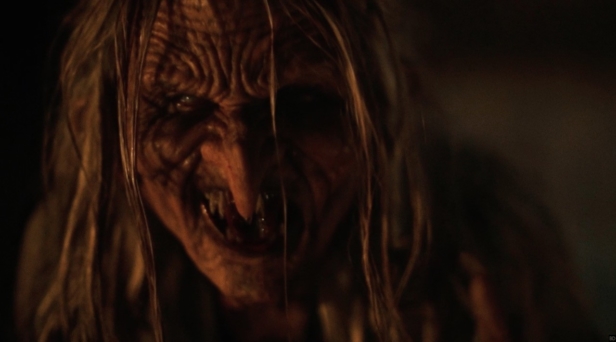Thursday 1 March
Last year it was Storm Doris that frustrated non-Glaswegian genre fans’ attempts to make their annual pilgrimage to the Glasgow FrightFest. This year the Curse continues with the UK-wide (and very much Glasgow-centred) cold snap which has brought rail, road and air transport to a grinding halt, put Glasgow in effective lockdown, and played havoc with several other Glasgow Film Festival screenings. On Thursday morning, the city’s Buchanan Galleries shopping centre, with none of its stores open, felt like the Monroeville Mall from Dawn Of The Dead – and a post-apocalyptic chill had spread over the rest of the metropolis now dubbed Glasnow. All of which, at least for those able to make it to the GFT, brought a special horror vibe to the proceedings, as everyone huddled together for the warmest place to hide, and dreaded having to venture outside once more. Even the snowstorm’s name – the Beast of the East – seemed to embody the spirit of a minifest filled with monstrous apparitions, bestial impulses and creature features.
The event opened Thursday evening with Jeremy Dyson and Andy Nyman’s multi-layered Ghost Stories (reviewed here) – although its writer/directors Jeremy Dyson and Andy Nyman (the latter also starring) were, like the FrightFest organisers, unable to arrive in time to attend owing to the weather conditions. For similar reasons, sadly Brian O’Malley’s aqueous Irish gothic The Lodgers (reviewed here) had to be pulled from the late slot.
Friday 2 March
The Wanderers: Quest Of The Demon Hunter (2017)
A desert road in the American interior (or as close to that as you can get while filming in Romania). A classic Ford drives up, with Louisiana plates and a rock song blaring from its stereo. Ageing Louis (Armand Assante, Prophecy, Sicilian Vampire) gets out, and says ‘Shit’ as he looks to the side of the road. For where he was expecting to find a single, rectangular hole that he had dug in the ground earlier, there are now in fact two. An old red pick-up arrives, and a relieved Louis greets his friend and colleague Igor (Branko Djuric): “I seen that second grave, man, I got so spooked.” Both of them have captives in their vehicles whom they intend to kill and dump. Indeed, Dragos Buliga’s feature debut, the somewhat cumbersomely titled The Wanderers: Quest Of The Demon Hunter, seems to be introducing us to a pair of amoral killers for hire, as if in some Tarantino-esque caper – but it is then quick to shift gears and switch genres by revealing that the prisoners are in fact demons, and that these two men are dedicated to eradicating ‘negative entities’ from an oblivious America. Still, that initial ambiguity – where heroes first appear as villains – will remain crucial in a film keen on humanising its demons and demonising its humans.
“Seriously, don’t you think it’s a bit too much of a cliché that a vampire slayer eats rare steak and on top of that drinks red wine,” observes journalist Robert (Lior Ashkenazi, Big Bad Wolves) of the paradoxical, larger-than-life Louis – played, overplayed even, by Assante as part hard-drinking cowboy, part grumpy, lecherous Christian and part washed-up, Vegas-era Elvis. Robert tells Louis about a manor house in a Transylvanian village whose last owner, Max, was recently slaughtered, along with his all-male drinking guests, supposedly by the vindictive ghost of a local girl (Oana Marcu) whom Max had previously assaulted and accidentally killed. So it is that Louis joins Robert, their Romanian guide Sorana (Raluca Aprodu) and a pair of Korean reality-tv makers (Bae Jung-hwa, Ho Jae Sun), on a foreign mission that will turn out to be linked very closely to Louis’ own personal history. For this ghostbuster, who is in many ways akin to the demons that he hunts, heads to Transylvania to exorcise a murderous creature who is also a victim within her own narrative of rape revenge and abandonment, and closely intertwined with his own (possibly eternal) history.
To my mind, most of the characters are woefully underwritten, some of the musical cues work to undermine rather than underscore the action, the plotting is overdetermined to the point of making little sense, and actors of Assante’s and Ashkenazi’s calibre are largely wasted on their cartoonish rôles. Still, with its international cast, its dialogue in English, German, Romanian and Korean, and with its border-transcending mix of ghosts, curses, possessions and demons, this truly multicultural film finds a way to bring what Louis terms ‘gentrification’ to what might easily have been just another hoary old Romanian house of horror. Louis and Igor’s constant, jokey confusion of Austria with Australia and Transylvania with Pennsylvania might just be The Wanderers‘ way of suggesting that this age-old tale of the conflict between good and evil is not only timeless, but also ubiquitous, indeed universal.
Attack of the Bat Monsters (1999)
“Listen to me. Attack Of The Bat Monsters will probably play the drive-in circuit for a couple of months, that European version will fall off the face off the planet, and that’s the last anyone will ever see of it.”
There are in fact two films called Attack Of The Bat Monsters: the one a B movie made in 1959, on which the speaker of these lines, Chuck Grayson (Michael Dalmon) has just served as assistant director, ghost writer and stuntman; and the other the Super 16mm feature debut of writer/director Kelly Greene made four decades later, which premièred in 2000 at the Dances With Films Festival (winning the Grand Jury for Best Film despite being edited on BetaSP) and then, more or less fulfilling Chuck’s prediction for the homonymous film-within-a-film, would disappear from sight after failing to secure a distributor. In 2009, however, Watchmaker Films’ Mark Rance (who had previously restored Tobe Hooper’s debut Eggshells) offered to scan the negative to 2K – and the results have their World Première at this year’s Glasgow FrightFest.
When director Francis Gordon (Fred Ballard) – obviously modelled on Roger Corman – wraps a schlocky indie monster movie three days ahead of schedule, unwilling to lose the extra time that he has hired at his Bronson Canyon-like quarry location, he decides to shoot another film on the fly, despite having an exhausted cast and crew – and as yet no script. The resulting slice of slyly observed metacinema approximates what it celebrates: an ultra-low-budget yet endearing indie film that is also a retro love letter to ultra-low-budget filmmaking from a previous era when writers were upper-popping beatniks, when actresses had only to perfect the art of screaming and stumbling, when Shakespearean luvvies and pedigreed lushes were welcome (but method actors were not), and when monsters were just interns in bad costumes. Peppered with references to actual Corman productions, and intercutting its on-set colour footage with black-and-white sequences (some dubbed badly into French) from the giant bat movie being made, this pulls no punches about the opportunistic manipulativeness of Gordon, but it also emphasises the hard work and solidarity of all involved in these disposable films, and always takes its characters at least semi-seriously.
Though made for peanuts, Attack Of The Bat Monsters is a blast of affection for cinema’s independent margins “with their cheap exploitation crap”, and more than earns its place among bigger-budgeted but similarly-themed films like Joe Dante’s Matinee (1993), Tim Burton’s Ed Wood (1994) and the Coen Brothers’ Barton Fink (1991) and Hail Caesar! (2016).
The Ravenous (2017)
“Whatever I saw out there, I’ve never seen that.”
These words, coming from Bonin (Marc-André Grondin), one of an ensemble of characters who eventually come together in The Ravenous (Les Affamés), also articulate the challenges facing Quebecois writer/director Robin Aubert (Saint Martyrs Of The Damned, 2005; À l’origine d’un cri, 2010) in tackling the already overcrowded zombie market. How do you come up with something viewers have not seen before in a subgenre that has seemingly been done to death? Aubert’s solution to this problem is twofold: first, to keep much of the familiar zombie business off screen and out of view, so that he can instead focus on his traumatised characters and their existential quests for meaning in their newly stripped-down, forced-back-to-basics life; and second, to emphasise, often with great humour, the banal absurdity of their predicament, as well as the more surreal aspects of the zombies’ emerging culture. For much as The Ravenous opens with the dreamlike image of a wooden chair placed in the middle of a mist-covered field, the film continues in a similar vein, taking the everyday furnishings of human experience and reconstituting them into defamiliarised objects of scrutiny. We have seen those things before, but not quite like this, imitating ordinary life while also de- and re-constructing it.
The core scenario is recognisable from countless other films: a national, perhaps global outbreak has reduced those infected to fast, flesh-hungry ragers, and everyone else to lost folk, haunted by the acts of murder that they have had to enact against their own loved ones in order to survive – apart from Demers (Martin Héroux), who seems entirely unaware that half the community has become zombies, and who keeps showing up at random moments to provide a hilariously ill-judged jump scare. In a rural area outside Quebec, Bonin and others – some relatives, some complete strangers – join forces in an attempt to rebuild a sense of domestic belonging, and eventually travel cross country together in the hope of finding somewhere safer to live. Bonin forms something of a family unit with the accordion-toting, possibly bitten Tania (Monia Chokri) and the recently orphaned Zoé (Charlotte St-Martin). These characters and others always seem entirely real, flawed and often very funny, even as their circumstances prove so harrowing – and it is this examination of human behaviour in extremis which makes The Ravenous, for all its bleakness, so unremittingly entertaining.
Meanwhile, the zombies’ collective conduct is not so very different from that of their still-living counterparts. George A. Romero’s Dawn Of The Dead (1978) famously had zombified Americans mindlessly wandering the interiors of a mall, because, as one character puts it, “This was an important place in their lives.” The Ravenous imagines a similar idea in an isolated area where there are no malls, and so its zombies’ dead-eyed worship of their past must take on a rather different form, even more eerie and estranging than Romero’s shopping centre: a bonfire of the vanities, so to speak, both parodying and parroting the essential appurtenances that make up our identity. This image, building upon the opening shot of the chair and recurring at various points in the film, pays off in a truly bizarre post-credits coda that brings the film’s principal themes (the longing for togetherness, home and love) into place. The closest analogue is Tod Williams’ Cell (2016), but Aubert’s brilliant film is very much riding its own course, offering something that has not been seen before.
Cold Skin (2017)
The latest film from Xavier Gens (Frontier(s), 2007; The Divide, 2011), Cold Skin opens with a familiar quote from Nietzsche about the dangers of becoming like the monster you are fighting, and then with a shot of a ship’s huge metal keel cleaving through the water, filmed from below as if from the point of view of a subaquatic creature (like the dolphins that we can see swimming alongside). “What are you running from?” the ship’s captain (John Benfield) asks his only passenger (David Oakes). After all, you have to be running from something to accept a year’s employment as a weather official on a desolate island of the Antarctic Circle. We never learn what the poetic, philosophical young man is leaving behind, or even his real name (he will later be nicknamed ‘Friend’) – but what we do know is that, more by accident than design, Friend is evading the horrors of the Great War, which will break out on the other side of the world shortly after he arrives on the island. Nonetheless, he is just as inadvertently stepping into another war, as he finds his own predecessor Aldo Vigeland missing (said to have succumbed to typhus), and the island’s only other human inhabitant, the gruff, older lighthouse keeper Gruner (Ray Stevenson), engaged in a constant battle with armies of aquatic humanoids (dubbed ‘Toads’) that swarm ashore at night.
“Darwin was wrong,” Aldo had scribbled into his notebook. Yet if this island harbours a missing link between man and monster, it also represents a boundary between land and water, civilisation and wilderness, all of which must be negotiated by its denizens (of either species). With his house reduced to a burnt ruin, Friend enters an uneasy alliance with Gruner, a Nietzschean antihero who is so consumed with Ahab-like hatred for the creatures outside that he has forgotten his own human identity, and now devotes every hour of darkness to exterminating their kind. The one exception is a female creature whom Gruner keeps for a pet – and for another, more taboo purpose. Significantly resembling Dren from Splice (2009), she represents a different, more loving form of relationship with otherness, as well as introducing something of a bizarre interspecies love triangle to all the endless internecine fighting.
Adapted by Jesús Olmo (28 Weeks Later, 2007) and Eron Sheean (Errors Of The Human Body, 2012) from the 2002 novel Cold Skin (La Pell Freda) of Catalan author Albert Sánchez Piñol, Cold Skin takes in a range of unexpected intertexts – from The Shining (1980) to Ex Machina (2014) – to explore the innate human (or at least male) hostility that militates against love, and the (perhaps) never-ending cyclicality of history that so easily keeps us insulated and exiled from our better selves. Think of it as the darker flip(per)side to The Shape Of Water.
Primal Rage (2017)
The film opens with a familiar beeping sound – an alert to fasten your seatbelt – and a shot, taken from within a car, of its departure from a city garage, onto the highway, and eventually winding through deep forestland. This is the Pacific Northwest, and Ashley (Casey Gagliardi) is on her way to pick up her husband Max (Andrew Joseph Montgomery) from just over a year’s stint in jail. Their relationship is a touch brittle, and their attempts to make up for this with a bit of roadside car sex on the way home are undermined when Max goes at Ashley like a wild animal and comes almost immediately. To Ashley’s horror, Max tells her that the one lesson he learnt inside was “how to make a shiv.” They long to restore normalcy with their toddler son, but they may not make it home – for en route, they sideswipe a near naked (and apparently mutilated) man, and after being pelted with rocks from the treeline above, end up in the freezing river and spending the night in the woods.
Meanwhile, in the nearby town of – movie reference alert!- Henderson (as in Harry And The Hendersons), the Native American Sheriff (Eloy Casados) is searching for another missing person. The crazy clerk (Matt Herold) at the local gas station tells him it’s a Bigfoot that’s taking them all, and more surprisingly the young Deputy (Justin Rain), also Native American, agrees. A group of male hunters who have offered to help Ashley and Max find their way out of the forest are menacing and, well, predatory from the outset, with clear sexual designs on Ashley – but there is also a much bigger threat afoot, with a heightened aggression towards all the men in its territory, and a different kind of interest in the one woman there. Still, Ashley is well used to tolerating quickie sex, and Max knows his way around an improvised blade.
Apparently named after the 1994 Atari video game (that featured a giant ape-like creature as one of its fighters), Primal Rage is the feature debut of Patrick Magee as writer/director/producer. Magee, however, is already well known for his make-up and special effects work in genre films like Spider-Man (2001), Beyond Re-Animator (2003) and Zombie Strippers (2008), and so it is that this film’s best asset is the mythic ‘Oh-mah’ at its hardwood centre. Unlike sasquatches seen in previous films, this one wears rudimentary clothing and a bark mask, uses weapons and tools, and comes with the modus operandi, even to a degree the appearance, of an alien Predator (indeed, Magee worked on the creature crew for 2004’s AVP: Alien vs. Predator). As civilisation fast gives way to the wilderness, Primal Rage becomes ever more brutal and gory, while introducing some witchy, peyote-inflected Native mysticism that never quite fits the rest of the film’s tone. Still, once the gruesome slaying starts, you had better fasten your seatbelt.
Check back tomorrow for reviews of the films playing at Horror Channel FrightFest Glasgow day 3!
